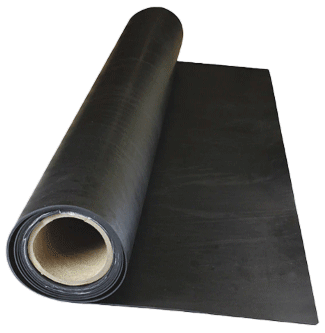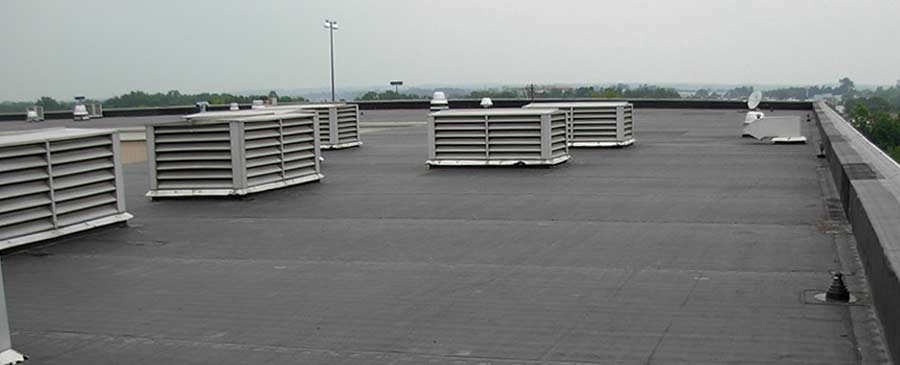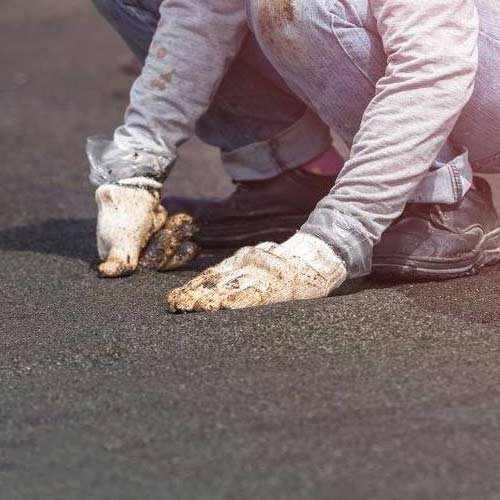EPDM Roofing
Commercial Roofing Contractor Serving Bradenton and Sarasota
Also known as “rubber roofing,” EPDM is widely favored in the commercial roofing industry for its long useful life, low carbon footprint and inherent resistance to damage of all kinds. While it’s mostly used in commercial applications, EPDM is also ideal for use in some residential applications, such as carports, roof patios or other flat roofs with minimal protrusions. Regardless of the building it’s installed on, EPDM rubber roofing has great potential as a roofing membrane due to its cost savings, energy efficiency and low maintenance requirements.
What is EPDM Roofing?
Ethylene propylene diene terpolymer (EPDM) is a synthetic rubber that is a popular material for roofing membranes for low-slope or flat roofs throughout the US and abroad. The material’s low carbon footprint and variety of customizations make EPDM an attractive choice in commercial roofing applications as well as low-slope or flat residential roofs. EPDM roofing is also:
- Flexible The flexibility of this rubber roofing helps it to resist damage due to foot traffic, extreme weather conditions and building movements.
- Long-lasting Properly installed and maintained, EPDM can last up to 50 years, though its typical lifespan is roughly 25–30 years.
- Cost-efficient The reasonable price of the materials combined with a lower labor cost, heating and cooling savings and long useful life make EPDM an economical choice.
- Puncture- and leak-resistant The flexibility of the material means it’s not as vulnerable to damage and water as other types of roofing materials.
- Fire-resistant EPDM is manufactured with a fire-retardant layer, which not only impedes the progress of a fire, it’s nearly impossible to ignite.
- Wind-resistant As it is applied in large sheets with a minimal number of seams, EPDM roofing is extremely resistant to wind damage and uplift force.
- UV reflective & energy efficient While EPDM is typically black, it can be coated in a white acrylic-titanium dioxide paint, which makes the surface extremely reflective. The UV rays of the sun reflect off of the surface, helping to keep the building cooler and saving energy costs.
- Environmentally friendly EPDM is not only created from recycled materials but once it has reached the end of its useful life it can again be 100% recycled.
Framework & Performance
EPDM rubber roofing comes in sheets that can be laid or rolled out in sections over the roof and is available in a range of widths and thicknesses. The sheets themselves are composed of several layers:

- 1. Top layer (optional) - Stone ballast
- 2. Top layer (optional) - White acrylic coating for reflectivity
- 3. Top layer (sans white coating) - Reinforced polyester for added strength
- 4. Middle layer - Fire retardant layer
- 5. Bottom layer - Elastomeric (adhesive) layer
These layers work together to create a versatile, durable membrane that will protect the roof for 25–50 years with proper maintenance.
EPDM that has been coated with white acrylic paint containing titanium dioxide has greater UV reflective ability than uncoated EPDM. This coating helps to keep the building cool, increases energy efficiency and adds to the length of the useful life of the roof. Furthermore, EPDM is able to stand up to extreme weather variations ranging from -40℉ up to 300℉.
EPDM’s layered composition makes the membrane remarkably durable, giving it a high amount of resistance to fire, thermal shock, punctures, rain and wind. If damage does occur, it’s fairly easy to fix using a patch or a layer of liquid membrane.
Assembly
There are a few assembly methods to choose from when installing an EPDM roofing membrane. The needs of the building owner and the conditions related to the geographical location should be considered when choosing the assembly method to be used. All of the assembly methods use large sheets of EPDM to drastically reduce the number of edges and eliminate nearly all possibility of wind penetration, meaning the edges stay flat and uplift force is not a problem.
There are three main types of assembly for EPDM roofing:
Fully adhered
Fully adhered systems are versatile; they are recommended for buildings of all sizes and configurations, including high-slope applications. The fully adhered system is lightweight, strong and has greatly advanced technologically in recent years, making the system one of the most popular roofing choices in many regions.
Installation Process:
- Sheets of insulation are adhered or mechanically fastened to the decking.
- Sheets of EPDM rubber roofing are attached to the insulation using bonding adhesive, with the sheets’ edges overlapping one another.
- Seams are sealed with seam tape.
- The perimeter of the roof, as well as any penetrations, are flashed according to technical specifications.
Mechanically-fastened
Mechanically-fastened EPDM roofing systems are preferred when a lightweight system is desired. They can be installed on almost any type of building as long as the decking is strong enough for the fasteners to be attached through the membrane or to the side laps. Many types of buildings can benefit from using this type of system due to its strength and versatility.
Installation process:
- Sheets of insulation are laid on the roof decking and fastened using adhesive or mechanical fasteners.
- EPDM sheets are laid on top of the insulation with overlapping edges.
- Seams are sealed with seam tape and then mechanically fastened.
- The edges of the roof and any penetrations are appropriately flashed.
Ballasted
The ballasted system is preferred by some building owners for its durability, ease and speed of installation and cost-effectiveness. The ballast adds fire resistance to the system, as rocks don’t typically burn. The ballasted system has EPDM sheets laid over insulation, unadhered and held in place by smooth river stones, gravel or concrete pavers. Ballasted systems are limited for use on structures that can support the additional weight of the stones and are typically best used on flat roofs that have minimal penetrations, such as carports or warehouses.
Installation process:
- Insulation sheets are laid on the roof’s decking without adhesive.
- EPDM sheets are loosely laid on top of the insulation, overlapping the edges of one sheet with another.
- Seams are sealed with seam tape.
- The roof’s perimeter and any penetrations are flashed.
- The entire roof is covered with ballast.
Is EPDM right for your building?

Choosing the right roof for your building considers many factors, including the size of your roof, your area’s climate and your planned budget. AKVM can help you go through the options available and provide you with the information you need to make an informed decision. Our roofers are experts at all roofing types and installation methods, and we guarantee our workmanship as well as the materials we use. Our goal is to give you a roof that you love, is safe and lasts a long time.
Contact us today to learn more about EPDM roofing membranes

Contact Us Today!
If you are in need of a knowledgeable roofing contractor that specializes in modified bitumen roofs, the industry-leading team at AKVM can help. We offer competitive pricing, financing options, and free in-person evaluations and quotes. Contact us with any questions you may have, we will be happy to assist you.